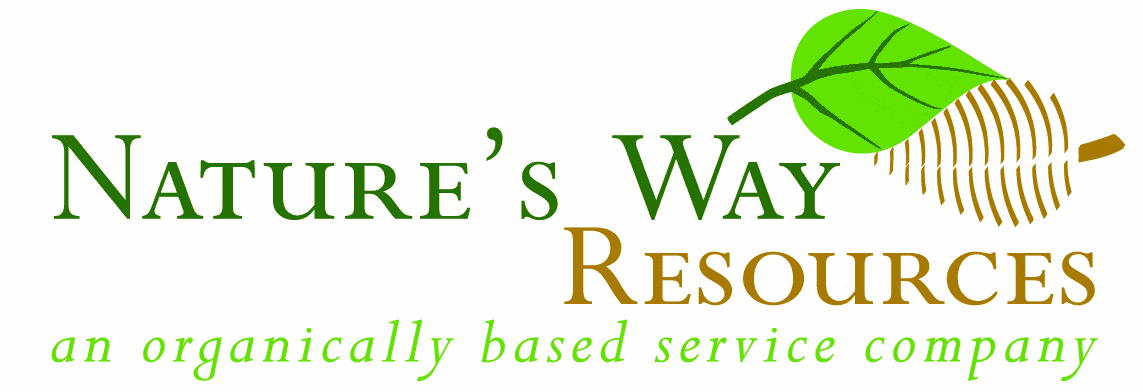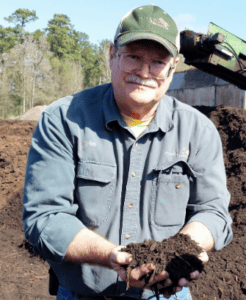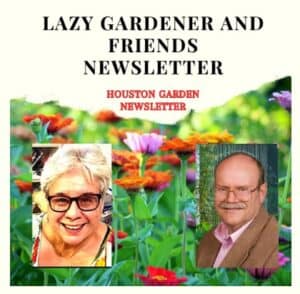 Nature’s Way Resources is proud to produce & email you this free weekly newsletter. We have no ads, but sponsors do graciously help support this project as a public service. Please note their names below & show your gratitude for this free service by patronizing their businesses! To become a sponsor, call (936) 273-1200
Nature’s Way Resources is proud to produce & email you this free weekly newsletter. We have no ads, but sponsors do graciously help support this project as a public service. Please note their names below & show your gratitude for this free service by patronizing their businesses! To become a sponsor, call (936) 273-1200
Nature’s Way Resources owner John Ferguson, “The Lazy Gardener” Brenda Beust Smith and Pablo Hernandez welcome your feedback and are so grateful to the many horticulturists who contribute their expertise
Click here to join our email list
CLICK HERE for PDFs OF PAST LG&F NEWSLETTERS
“Of course everything is blooming most recklessly: if it were voices instead of colors, there would be an unbelievable shrieking into the heart of the night.”
— Rainer Maria Rilke, Austrian poet and novelist
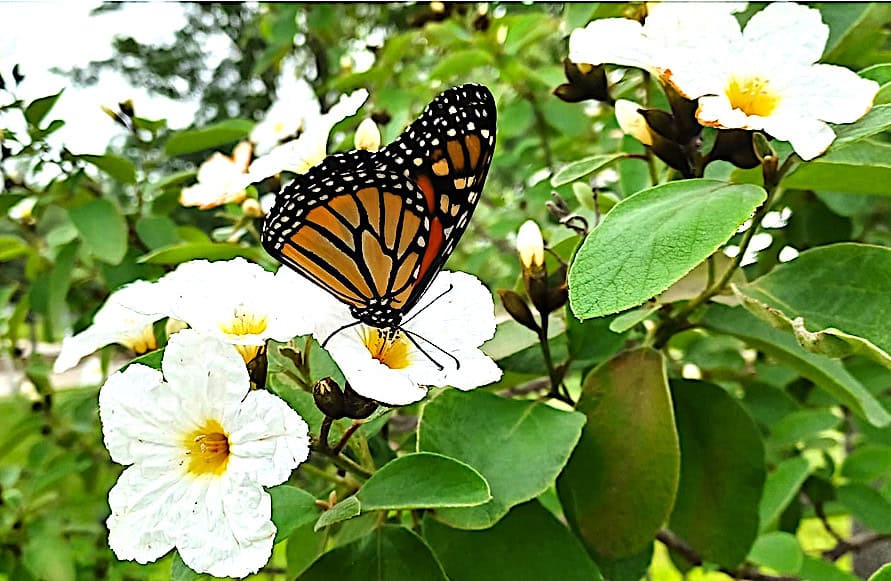
Texas Olive Tree (Cordia boissieri (Liliana R. Cracraft photos above & below)
SPECTACULAR YEAR FOR TEXAS OLIVE TREES!
BY BRENDA BEUST SMITH
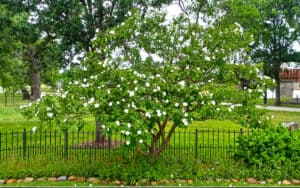 LILIANA R. CRACRAFT —best known for her Houston Cactus & Succulent Society work – sent theseTexas Olive Tree(Cordia boissieri)pictures (above & right). I have long wanted one, so jealous every time I visit Buchanan’s Native Plants(where a spectacular one has delighted customers for decades!)
LILIANA R. CRACRAFT —best known for her Houston Cactus & Succulent Society work – sent theseTexas Olive Tree(Cordia boissieri)pictures (above & right). I have long wanted one, so jealous every time I visit Buchanan’s Native Plants(where a spectacular one has delighted customers for decades!)
TEXAS OLIVE TREE (Cordia boissieri) — not a “real” olive (or a cacti) — is a Chihuahuan Desert native. Prune into a large shrub or leave as 25+/-‘ tree with butterfly-attracting blooms throughout year, most heavily late spring- early summer, then off/on when weather’s right. Birds, deer & cattle love the olive-like fruits, (not tasty to us). Also called Mexican olive and Anacahuita.
 IN OUR SPOTLIGHT ARTICLE BELOW, TERRA BURNS details the successes Montgomery County Master Gardeners are having with Square Foot Gardening.
IN OUR SPOTLIGHT ARTICLE BELOW, TERRA BURNS details the successes Montgomery County Master Gardeners are having with Square Foot Gardening.

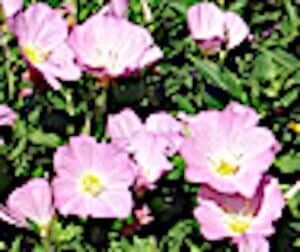 TIP O’ THE TROWEL TO MOWERS! Have you noticed how many more pink evening primroses (Oenothera speciosa) and other oft-unseen native wildflowers are decorating our streets & highways? Obviously powers-that-be (local, city, county, highway, homeowners etc.) have decreed ignoring or volunteering-not to-mow areas of ‘bulk’ wildflowers.
TIP O’ THE TROWEL TO MOWERS! Have you noticed how many more pink evening primroses (Oenothera speciosa) and other oft-unseen native wildflowers are decorating our streets & highways? Obviously powers-that-be (local, city, county, highway, homeowners etc.) have decreed ignoring or volunteering-not to-mow areas of ‘bulk’ wildflowers.
This has been extra-nice since many usually-spectacular bluebonnets were somewhat overpowered by weather conditions, etc. Whatever the cause . . . THANK YOU!!!: Encourage this phenomena! Write your County Precinct Judge that you noticed and approve!
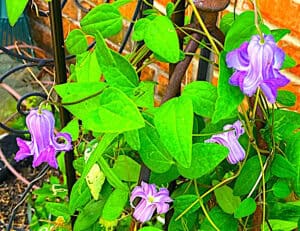 MEA CULPA, CLEMATIS! Thanks to MARGARET CHERRY who pointed out last week I mis-identified my beloved clematis, right. Margaret says mine (right) is a Clematis crispa, (swamp clematis) which, she adds, needs to be grown more in our area.
MEA CULPA, CLEMATIS! Thanks to MARGARET CHERRY who pointed out last week I mis-identified my beloved clematis, right. Margaret says mine (right) is a Clematis crispa, (swamp clematis) which, she adds, needs to be grown more in our area.
 Margaret recommends potting these in gallon container for another season before early spring planting in ground. Clematis texensis (right) also do well here. An added benefit: there are many excellent, easy-to-come-by hybrids such as, pictured, Duchess of Albany, left, and Princess Diana, especially good ones for us!
Margaret recommends potting these in gallon container for another season before early spring planting in ground. Clematis texensis (right) also do well here. An added benefit: there are many excellent, easy-to-come-by hybrids such as, pictured, Duchess of Albany, left, and Princess Diana, especially good ones for us!
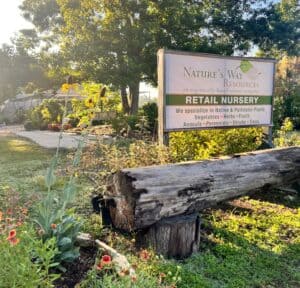 ATTN. GARDEN/PLANT GROUPS — Nature’s Way Resources offers free guided tours of NWR’s extensive nursery/soil/mulch facilities for garden clubs, plant societies and other plant-oriented, organized groups. As usual, NWR’s now-expanded meeting site is free to above groups. Reservations a must for both. Great time to visit!
ATTN. GARDEN/PLANT GROUPS — Nature’s Way Resources offers free guided tours of NWR’s extensive nursery/soil/mulch facilities for garden clubs, plant societies and other plant-oriented, organized groups. As usual, NWR’s now-expanded meeting site is free to above groups. Reservations a must for both. Great time to visit!
- SUBMITTING CALENDAR EVENTS?: These will be in next upcoming newsletter ONLY IF SUBMITTED IN OUR EXACT FORMAT they may be held until can be reformatted. Otherwise, they may be held for reformatting. PS. Apr, 14 National Gardening Day. – You take it from there
Spotlighting . . .
Montgomery County Master Gardeners

Grid evident and plants by portals. L to r: Basil, kale, Micro Tom tomatoes and taquito peppers. ‘Little pickler cucumbers next to wire trellis. Right: What happens when you don’t pay attention to the details: over-growing its box
SQUARE FOOT GARDENING
BY TERRA BURNS
MONTGOMERY COUNTY MASTER GARDENER
MGMG Square Foot Garden Manager
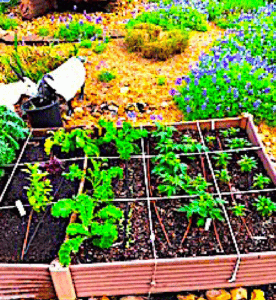 WHAT IS A SQUARE FOOT GARDEN? A way to grow a variety of edible plants in a small space. This method is useful because it saves you water, time, space, effort and money (as far as the purchase of seeds and soil and tools) How to do it?
WHAT IS A SQUARE FOOT GARDEN? A way to grow a variety of edible plants in a small space. This method is useful because it saves you water, time, space, effort and money (as far as the purchase of seeds and soil and tools) How to do it?
- Choose an area that gets 6-8 hours of direct sunlight, good drainage.
- 4ft x 4ft is the standard size but varies with preference.
- Choose a bottom: weed mat, landscape fabric, cardboard.
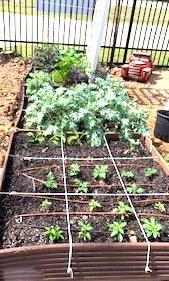 Construct a box 8″-12″ high from material of your choice. This can range from bricks, to wood, to plastic, to metal, to cinder blocks etc….
Construct a box 8″-12″ high from material of your choice. This can range from bricks, to wood, to plastic, to metal, to cinder blocks etc….- Fill the box with a home made soil mixture (Mel’s Mix of 1/3 vermiculite, 1/3 sphagnum peat moss or coconut coir, and 1/3 compost from at least 3 different sources) or store bought garden soil.
- Select and install what you plan to use for watering, whether using drip irrigation, a soaker hose, hand watering or a sprinkler system
- Put a grid in place that denotes each square foot. This can be made with cord, wood, or any material of your choosing.
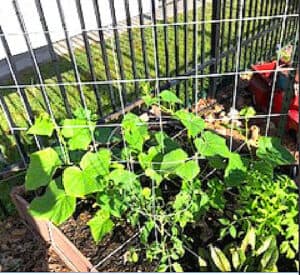 Select plants that do well in your area and that are compact. Decide if you will direct seed or buy existing plants.
Select plants that do well in your area and that are compact. Decide if you will direct seed or buy existing plants.- Put plants/seeds in the soil based on recommended spacing for the mature plant in a square foot garden taking in consideration where the sun is located in reference to shading, where taller plants won’t shade shorter plants.
LESSONS LEARNED:
- If you continue to plant the same family of plants in the same area, plants become diseased and decline in productivity. Rotate your crops!
- If using drip irrigation, place the seeds/plants where the portals are located. Symmetry and spacing in a box is less important.
- Tendrils from vining plants can’t wrap around bulky trellis parts that are too wide.
- Watch for and don’t ignore bugs; they just continue to multiply.
- Read the detailed information about what you are planting, otherwise you may end up with something that takes over the garden and won’t stay in its designated box.
Great resource: “Square Foot Gardening”
John’s Corner
NEWS FROM THE WONDERFUL WORLD
OF SOIL AND PLANTS
Subject: How Can I help corn plants and water glyphosate atrazine
Doug has done it again and written an easy-to-read book that answers most people’s questions on how to garden in a way that is good for nature.
How Can I Help? Saving Nature with Your Yard by Doug Tallamy, Timber Press, 2025, ISBN: 978-1-64326-471-4
He states that there are 135 million acres in the USA that are residential landscapes. Everything we plant, don’t plant, or apply to our yard impacts the greater ecosystem in which our yards exist, and thus everything that depends on that ecosystem.
For example, “when we plant an invasive plant (e.g. Chinese tallow), we are harboring ecological tumors whose offspring escape our landscape, negatively affecting our neighbor’s property as well as the natural space around us.”
From the publisher:
In How Can I Help?, Tallamy tackles the questions commonly asked at his popular lectures and shares compelling and actionable answers that will help gardeners and homeowners take the next step in their ecological journey. Topics range from ecology, evolution, biodiversity and conservation to restoration, native plants, invasive species, pest control, and supporting wildlife at home. Tallamy keenly understands that most people want to take part in conservation efforts but often feel powerless to do so as individuals. But one person can make a difference, and How Can I Help? details how.
Whether by reducing your lawn, planting a handful of native species, or allowing leaves to sit untouched, you will be inspired and empowered to join millions of other like-minded people to become the future of backyard conservation.
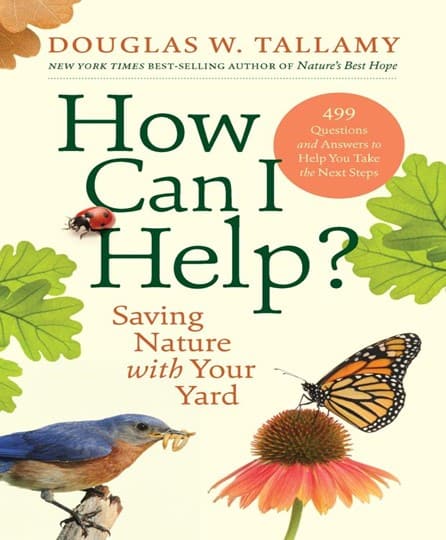
Plants know how to find water with their roots, it is built into their DNA. However, I was reading about a study that found that some varieties of high yielding corn plants have lost a portion of this ability to find water. The researchers examined 250 varieties of corn that are commonly used today.
A paper in the journal Scientific Reports has found that exposure to the glyphosate molecule (found in the herbicide Round Up), impaired glucose regulation, which is a major factor in the development of type-2 diabetes.
Ever wonder why there is so much dementia in society today? A couple contributing factors are glyphosate which is in almost all breads, cereals, candy bars, fast foods, etc. and atrazine which are used on our food supply. More reasons to go organic.
Another study published in the Journal of Neuroinflammation shows that exposure to glyphosate can lead to significant and lasting negative effects on brain health. Animal studies revealed significant brain inflammation after exposure to glyphosate. These pathological changes persisted for at least 6 months after exposure.
A recent study in the Journal Research found significant neurotoxic effects of the herbicide atrazine on the hypothalamus area of the brain. This increases the risk of neurodegenerative diseases.
SPONSORSHIP
If you are interested in becoming a sponsor, please contact us at 936-273-1200 or send an e-mail to: lazygardenerandfriends@gmail.com
ABOUT US
BRENDA BEUST SMITH
WE KNOW HER BEST AS THE LAZY GARDENER . . .
but Brenda Beust Smith is also:
- a national award-winning writer & editor
- a nationally-published writer & photographer
- a national horticultural speaker
- a former Houston Chronicle reporter
When the Chronicle discontinued Brenda’s 45-year-old Lazy Gardener” print column — started in the early ’70s as a fun side-project to reporting, it then ranked as the longestrunning, continuously-published local newspaper column in the Greater Houston area. The name, she says, is not just fun, it’s true.
Brenda’s gradual sideways step from reporter into gardening writing led first to an 18-year series of when-to-do-what Lazy Gardener Calendars, then to her Lazy Gardener’s Guide book which morphed into her Lazy Gardener’s Guide on CD, which she now emails free upon request.
Brenda became a Harris County Master Gardener and, over the years, served on theboards of many Greater Houston area horticulture organizations. She hosted local radio and TV shows, most notably a 10+-year Lazy Gardener specialty shows on HoustonPBS (Ch. 8) and her call-in “EcoGardening” show on KPFT-FM.
For over three decades, Brenda served as Assistant Production Manager of the GARDEN CLUB OF AMERICA’S “BULLETIN” magazine. Although still an active broad-based freelance writer, Brenda’s main focus now is THE LAZY GARDENER & FRIENDS HOUSTON GARDEN NEWSLETTER with John Ferguson and Pablo Hernandez of Nature’s Way Resources.
A native of New Orleans and graduate of St. Agnes Academy and the University of Houston, Brenda lives in Humble, TX, and is married to the retired Aldine High School Coach Bill Smith. They have one son, Blake.
Regarding this newsletter, Brenda is the lead writer, originator of it and the daily inspiration for it. We so appreciate the way she has made gardening such a fun way to celebrate life together for such a long time.
About her column, Brenda says: “I don’t consider myself a ‘garden writer.” I started out 50+ years ago as a very lazy “gardening reporter.” I still feel that way today. I hope my columns inspire/help newcomers, but I do not write to them. I write to very experienced gardeners who want to expand their horizons.
JOHN FERGUSON
John is a native Houstonian and has over 35 years of business experience. He owns Nature’s Way Resources, a composting company that specializes in high quality compost, mulch, and soil mixes. He holds a MS degree in Physics and Geology and is a licensed Soil Scientist in Texas.
John has won many awards in horticulture and environmental issues. For years he represented the composting industry on the Houston-Galveston Area Council for solid waste. His personal garden has been featured in several horticultural books and “Better Homes and Gardens” magazine. His business has been recognized in the Wall Street Journal for the quality and value of their products. He is a member of the Physics Honor Society and many other professional societies. John is the co-author of the book Organic Management for the Professional.
For this newsletter, John contributes articles regularly and is responsible for publishing it.
PABLO HERNANDEZ Pablo Hernandez is the special projects coordinator for Nature’s Way Resources. His realm of responsibilities include: serving as a webmaster, IT support, technical problem solving/troubleshooting, metrics management and quality control. Pablo helps this newsletter happen from a technical support standpoint.
Download the Newsletter with Our Events Calendar Below!
